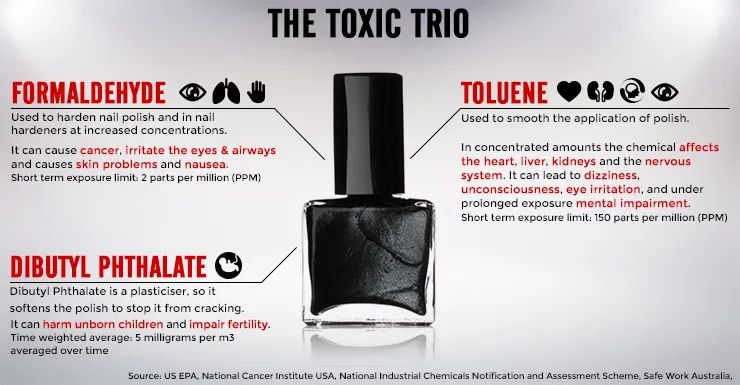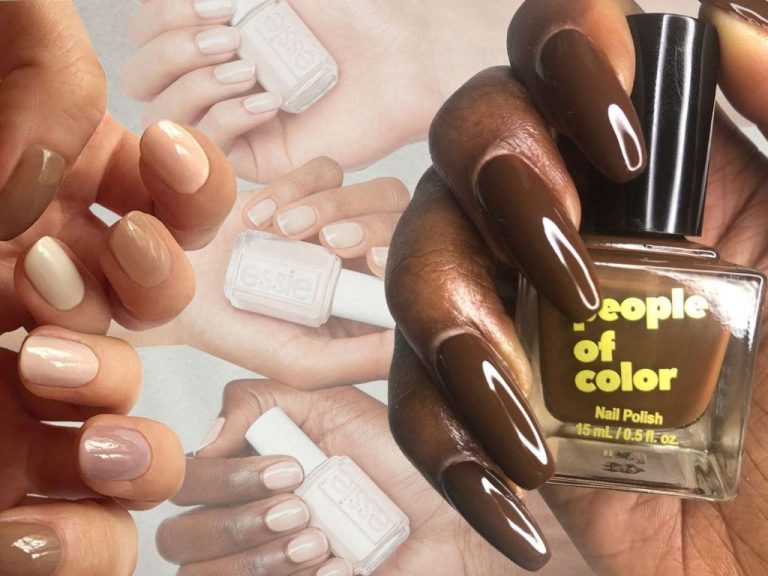Earth-Friendly Nail Care: Sustainable Products For Healthy Hands
Conventional nail polishes and products often contain a number of toxic chemicals that can be harmful to human health and the environment. Some of the most concerning chemicals found in traditional nail polishes include formaldehyde, dibutyl phthalates, toluene, and xylene (The Cut, 2023). Formaldehyde is a known carcinogen, while the other chemicals are linked to issues like hormone disruption, reproductive harm, and organ toxicity (Non-Toxic Revolution, 2019). These concerning ingredients can off-gas into the air and be absorbed through the nail bed into the body. There is growing awareness around finding nail polish options that do not contain these toxic chemicals.
Problems with Regular Nail Polish
Many conventional nail polishes contain harmful ingredients that can negatively impact health and the environment.
A major ingredient in traditional nail polish is formaldehyde resin, which is a derivative of formaldehyde. According to Harvard Health Publishing, formaldehyde in large doses can cause allergic reactions on the skin [1]. The Cut also notes that formaldehyde resin is commonly found in nail lacquer, though it is less carcinogenic than free formaldehyde [2].
Another concerning ingredient in many polishes is toluene, which can act as a skin irritant and disrupt hormone function with excessive exposure. It may also affect the nervous system and kidneys, according to research [3].
Dibutyl phthalate is an endocrine disruptor that is often added to improve flexibility in polishes. However, it has been linked to developmental and reproductive issues [3].
Health Risks of Traditional Nail Products
Many of the chemicals used in standard nail polishes and treatments can be hazardous to your health and well-being. The three main concerning ingredients found in conventional nail products are:
- Formaldehyde – Used in polish and hardeners, exposure can cause breathing issues like coughing and wheezing. Formaldehyde is also linked to headaches, allergic reactions, and eye/skin irritation (OSHA).
- Phthalates – Added to polish to increase flexibility and longevity, phthalates are associated with reproductive issues, decreased testosterone, ADHD, and diabetes (Forbes).
- Toluene – A solvent that helps polish apply smoothly, toluene exposure can lead to headaches, dizziness, and nausea.

The combination of these ingredients and the poor ventilation of many salons means nail technicians inhale up to 10 times more chemicals than e-waste workers (NCBI). Prolonged exposure poses significant health risks that should not be ignored.
Environmental Impact
Nail polish ingredients like toluene, formaldehyde, and phthalates can have detrimental effects on the environment when washed down drains. These chemicals are difficult to remove from wastewater and can persist in the environment for a long time. According to https://www.conserve-energy-future.com/is-nail-polish-bad-for-environment.php, when discarded, nail polish leaches toxic components into the soil and groundwater. In addition, nail polish is not considered biodegradable.
Eco-Friendly Alternatives
As concerns grow over the health and environmental impacts of traditional nail polishes, more eco-friendly options have emerged. These use ingredients that are much less toxic and better for the planet.
Look for water-based nail polishes made without the “toxic trio” – toluene, formaldehyde, and dibutyl phthalate (DBP). These chemicals are linked to issues like cancer, reproductive harm, and smog formation.
Instead, eco polishes use ingredients like:
- Plants – Corn, potato, rice, tapioca
- Minerals – Titanium dioxide, mica
- Natural pigments – Annatto, carmine
Some popular natural brands include Zoya, Jinsoon, and Olive & June. Their polishes give vibrant color without the nasty chemical cocktail.
Plant-based ingredients like corn and potatoes make the formulas more breathable. And they skip additives like formaldehyde that lead to chipping and peeling.
Overall, eco nail polishes provide a much healthier option for your nails and the environment. And the quality keeps improving, with great color payoff, shine, and wear time.
Ingredients to Look For
When shopping for eco-friendly nail polish, look for certain natural ingredients that make the polish safer and more environmentally sustainable. Some key ingredients to seek out include:
Citrus – Citrus extracts like orange or lemon peel oil act as natural solvents, replacing harsh chemicals like toluene. Citrus oils give nail polish a fresh, light scent.
Cornstarch – A natural thickening agent that replaces toxic additives like formaldehyde. Cornstarch helps give polish a smooth, even consistency.
Beeswax – Adds luster and shine to natural nail polish. Beeswax acts as an emollient to condition nails and cuticles.
Opting for plant-based formulas free of the “toxic trio” – toluene, formaldehyde, and dibutyl phthalate (DBP) – are ideal. Eco-friendly nail brands also avoid parabens, fragrances, and other unsafe synthetics in their polish.
Reading ingredient lists carefully and researching brands can help identify truly non-toxic polish made with safe, natural formula. For peace of mind, look for polishes labeled 10-free, 7-free, or 5-free.
Application Tips
Proper application is key to getting the most out of your eco-friendly nail polish and achieving a flawless, long-lasting manicure. Here are some tips for applying natural nail polish:
First, be sure to shake the bottle vigorously before each use to thoroughly mix the ingredients. Natural nail polishes can separate over time.
Apply thin, even coats of polish. Trying to apply too thick of a coat can lead to bubbling and chipping. Let each coat dry completely before moving on to the next.
Use a base coat first to protect nails and help adherence of color. Follow with two coats of your chosen nail polish. Finish with a top coat for added shine and chip resistance.
Caring for Your Nails
Proper nail care is essential for healthy, strong nails. Here are some tips for caring for your natural nails at home:
Removal
When removing nail polish, be sure to use a non-acetone nail polish remover. Acetone-based removers can dry out nails and skin. Gently scrub polish off with a cotton ball soaked in remover, being careful not to pull or peel the nails. After removing polish, apply a hydrating cuticle oil to condition the nails and cuticles (Source).
Cuticle Care
Cuticles protect the nails from bacteria and damage, so avoid cutting them. Gently push back cuticles after showering when they are soft. Apply cuticle oil daily to hydrate cuticles and prevent hangnails (Source).
Strengthening Treatments
For added strengthening, apply a nail hardening treatment regularly. Look for formulas with calcium, essential oils, or hydrolyzed wheat protein. You can also make your own strengthening treatment by mixing equal parts lemon juice and coconut oil and applying to the nails. Let sit 5-10 minutes before rinsing.
DIY Recipes
Making your own homemade nail polish is easy with just a few common household ingredients. Here are some simple recipes to try:
For a basic nail polish, mix together 4 tablespoons of olive oil, 3 teaspoons of alkanet root powder, and 1/2 teaspoon of beeswax. Alkanet root powder can be purchased online or at some health food stores. It provides a red pigment. Ginger root powder creates a neutral shade. Heat the mixture gently to melt the beeswax, then store in a jar. Apply 2-3 coats for best coverage.
Another easy option is mixing equal parts olive oil and vitamin E oil. Add a few drops of essential oil for scent if desired. The vitamin E boosts shine. For color, stir in a small amount of natural powdered pigment like turmeric, cocoa, or mica powder.
Nail polish made at home typically doesn’t last as long as store-bought. Focus on creating fun colors for pedicures or temporary manicures. Avoid ingredients like formaldehyde found in many conventional polishes.
Conclusion
As we’ve discussed, regular nail polish often contains harmful ingredients like formaldehyde, toluene, and phthalates. Exposure to these chemicals has been linked to health issues such as hormone disruption, asthma, and even cancer. On top of that, chemical ingredients get washed down drains and can pollute water supplies and harm aquatic life.
Choosing eco-friendly nail products is clearly better for both human health and the environment. Brands that use plant-based, non-toxic formulas prove that we can pamper ourselves without dangerous side effects. With some research and switching to sustainable ingredients, our beauty routines can avoid unintended consequences.
Caring for your nails also means adopting good hygiene habits and moisturizing cuticles to prevent breakage. Simple practices like washing your hands with mild soap, trimming nails regularly, and massaging in balm will keep your hands healthy and strong. For further nourishment, homemade recipes using oils and butters can hydrate nails and promote growth.
As consumers, we have power with our purchases. Seeking out ethical brands sends a message that there is demand for sustainable options that don’t sacrifice on performance. Together, our choices can move industries toward more responsible innovation and ingredients. With small steps, we can keep our nails beautiful in a way that’s gentle on bodies and the planet.





